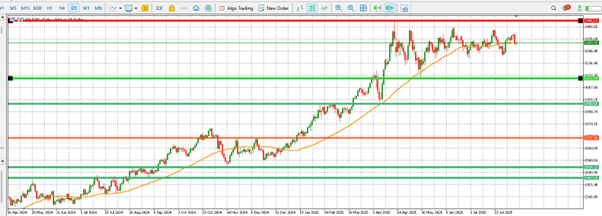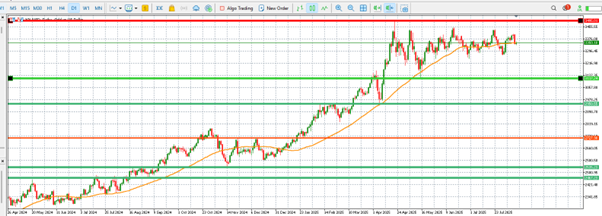Gold prices surged following the release of the latest U.S. Consumer Price Index (CPI) data, which showed no change month-over-month (m/m), remaining at 0.2%. Despite expectations that trade tariffs would exert upward pressure on inflation, the data suggests that these tariffs are not having the dramatic impact many had anticipated. This market development, along with rising expectations of a Federal Reserve rate cut, has contributed to gold’s rise to $3,354 per ounce, with the next resistance level seen at $3,500.
CPI Data Shows Inflationary Pressures Remain Subdued
The August CPI report indicated that inflation remained largely unchanged from the previous month, with the index holding steady at 0.2% m/m. Analysts had speculated that the ongoing trade tariffs between the U.S. and China would lead to a spike in inflation, particularly in sectors such as electronics, machinery, and consumer goods. However, the latest data reveals that these tariff-induced price pressures have not materialized as expected. While inflationary trends in core items like shelter, medical care, and apparel are still in play, the lack of significant upward movement in the CPI suggests that broader inflationary concerns may be overstated.
This outcome is critical for the gold market, as traders and investors closely monitor inflationary trends for indications of future monetary policy. Gold has long been considered a hedge against inflation, and the failure of trade tariffs to cause a significant inflationary surge has led to a more favorable environment for the yellow metal. As inflation expectations are revised lower, gold is benefitting from renewed buying interest, with prices testing key resistance levels.
Gold's Rally Driven by Rate Cut Speculation
The CPI report has fueled further speculation about a potential Federal Reserve rate cut. The current odds for a rate cut in the September meeting have surged to over 80%, bolstered by the ongoing pressure to ease monetary policy in light of persistent concerns about weak economic growth and low inflation. The Fed’s accommodative stance has been a key driver for gold’s rally in recent months, and the prospect of further rate cuts only strengthens the appeal of non-yielding assets like gold.
Gold's price action post-CPI data underscores this dynamic, with the precious metal rising to $3,354 per ounce, a level not seen in recent months. The next potential resistance level is at $3,500, a level that could be tested if the Fed moves ahead with a rate cut in September. The market is anticipating that the central bank will ease monetary policy further, particularly after the July Federal Open Market Committee (FOMC) meeting, where the Fed expressed concerns over slowing economic growth and global uncertainties.
Political Pressure from President Trump Heightens Rate Cut Expectations
However, traders should also be mindful of a key political factor that could influence the Fed’s rate decision: pressure from President Donald Trump. The U.S. President has been vocal in his demand for lower interest rates, believing that such a move would stimulate economic growth and weaken the U.S. dollar, which would be beneficial for U.S. exports. While the Fed has generally operated independently of political pressure, Trump's influence cannot be discounted, particularly given the close relationship between the central bank and the current administration.
This political pressure has added an element of uncertainty to the outlook for interest rates. Traders have been pricing in a 25 basis point rate cut, but the growing political pressure suggests that the Fed may be compelled to act more aggressively. If the Fed were to cut rates by more than 25 basis points, it would be a surprise to the market and could send gold prices even higher. The market is not fully priced in for such an outcome, meaning that any surprise in the Fed’s rate decision could trigger a sharp move in gold, with a potential surge toward the $3,500 resistance level.
What Traders Should Watch For
As traders navigate the gold market, several key factors should be monitored. The first is the upcoming Federal Reserve meeting in September, where expectations for a rate cut will be closely scrutinized. The odds for a 25 basis point cut are currently high, but traders should be prepared for the possibility that the Fed could take more aggressive action. Should the Fed surprise the market with a larger-than-expected rate cut, gold prices could rally significantly beyond $3,500.
Additionally, the geopolitical landscape remains an important driver of gold prices. Trade tensions, particularly between the U.S. and China, continue to create market uncertainty. Any developments that suggest a further escalation of trade conflicts or geopolitical risks could push investors toward safe-haven assets like gold, supporting further upside potential.

MT4 Chart by AvaTrade
Conclusion
The latest CPI data has reinforced the notion that trade tariffs are not exerting significant inflationary pressures on the U.S. economy. As a result, gold has benefitted from a rise in investor demand, driven by expectations of a rate cut by the Federal Reserve. The market is eyeing the $3,500 resistance level, which could be tested if the Fed delivers a rate cut in September. However, traders must also consider the potential for a more aggressive rate cut than currently priced in, driven by political pressure from President Trump. Such a move would have significant implications for gold prices, potentially driving the precious metal even higher.
